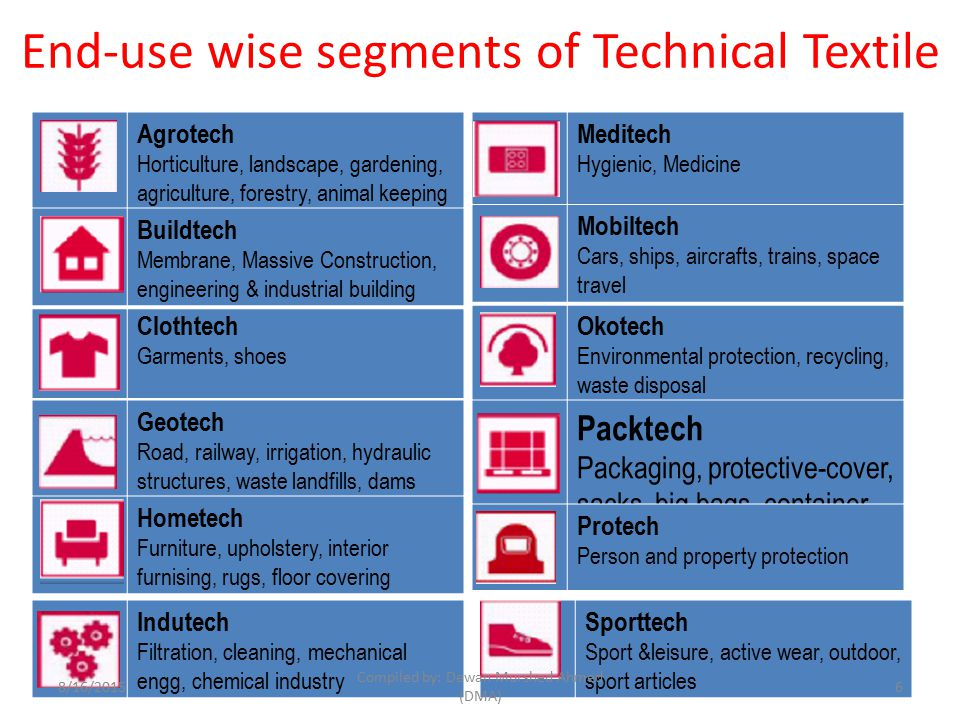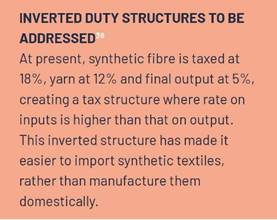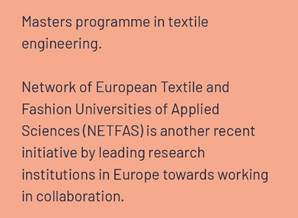Free Courses Sale ends Soon, Get It Now


Free Courses Sale ends Soon, Get It Now


TECHNICAL TEXTILES
Context
Technical Textiles

Global Market Size
Technical Textile in India
Government Initiatives to Boost Technical Textiles Market
Harmonized System of Nomenclature (HSN) Codes for Technical Textile
In 2019, the Ministry of Textiles, Government of India dedicated 207 HSN codes to technical textiles to help in monitoring the data of import and export, in providing financial support and other incentives to manufacturers. The purpose of this classification is to increase international trade, and enable the market size to grow up to $ 26 Bn by the year 2020-21.
100% FDI under Automatic Route Government of India allows 100% FDI under automatic route
International technical textile manufacturers such as Ahlstrom, Johnson & Johnson, Du Pont Procter & Gamble, 3M, SKAPS, Kimberly Clark, Terram, Maccaferri, Strata Geosystems have already initiated operations in India.
Technotex
India It is a flagship event organised by the Ministry of Textiles, in collaboration with Federation of Indian Chambers of Commerce & Industry (FICCI) and comprises of exhibitions, conferences and seminars with participation of stakeholders from across the global technical textile value chain.
National Technical Textiles Mission
With a view to position the country as a global leader in technical textiles, the CCEA has given its approval to set up a National Technical Textiles Mission with a total outlay of $ 194 Mn in February 2020.
The Mission shall be set up for a four year implementation period from FY 2020-24 and will have the following four components:
Schemes
Technology Mission on Technical Textiles (TMTT)
Centres of Excellence Ministry of Textiles had launched Technology Mission on Technical Textiles (TMTT) with two mini-missions for a period of five years from 2010-15 which entailed the creation of the following eight Centres of Excellence to provide infrastructure support, lead research and conduct tests of various technical textiles.
Amended Technology Upgradation Fund Scheme (ATUFS)
The Ministry of Textiles implemented ATUFS in January 2016, for a period of seven years. ATUFS’s larger objective is to improve exports and indirectly promote investments in the textile machinery. Under ATUFS, technology upgradation and CIS are offered to entities that are engaged in manufacturing textile and technical textile products under the guidance of TAMC (Technical Advisory Monitoring Committee).
Capitalising the $ 1.4 Trn Infrastructure Fund
Aligning with the Prime Minister’s vision of achieving a $ 5 Trn economy, the Finance Minister unveiled a $ 1.4 Trn national infrastructure pipeline in December 2019 which will be implemented in the next five years. The projects identified include energy, road, railway, urban development, irrigation and health sectors, where technical textiles can be used extensively.
SAMARTH (Scheme for capacity building in textile sector)
The scheme had an estimated budget of Rs. 1,300 Crores and aimed to train 10 lakh persons over a period of 3 years (2017-20). This scheme has tried to address the shortage of skilled manpower in textile sector, including technical textiles.
National Technical Textiles Mission (NTTM)
This is the most important, exclusive and ambitious scheme till date and it aims to position the country as a global leader in technical textiles market. Its aim is to take domestic market size of technical textiles industry to US$ 40-50 Billion by the year 2024 with an average growth rate of 15-20% per annum.
Way Ahead
Developing a National Textile Policy
In order to develop the textile industry into a strong and vibrant one, meet the growing needs of the people and contribute to sustainable growth of employment and economic growth, it is imperative that we have a sound and dynamic National Textile Policy. The National Textile Policy was released in 2000. With the textiles industry growing by leaps and bounds, there is a need for revising and updating the national textiles policy.
The revised policy should take stock of the changing domestic and global needs, acknowledge the potential of “the fourth industrial revolution”, improves the overall supply chain, including structural reforms to improve present trade practices. The policy should constitute an elaborate strategy on how to build the technical textiles industry, focusing on institutionalisation, standardisation, measures to deal with sustainability, R&D efforts to procure the fibres within India.
Research and Development
The technical textile sector in India is at a nascent stage and therefore R&D play a critical role to gain a lead in this sector. Recently, the government has also suggested creating a special fund for R&D worth $ 13 Mn in technical textiles. Along with these, more efforts will have to be made in the direction of fostering a well-developed R&D ecosystem.



Research and Development
The technical textile sector in India is at a nascent stage and therefore R&D play a critical role to gain a lead in this sector. Recently, the government has also suggested creating a special fund for R&D worth $ 13 Mn in technical textiles. Along with these, more efforts will have to be made in the direction of fostering a well-developed R&D ecosystem.
Creation of a National Centre for Research in Technical Textiles
The formation of a ‘National Centre of Research in Technical Textiles’ may be proposed as a first step towards creating a formal institutional structure. This may be established within an existing institution or as a separate entity.
FDI and formation of Joint Ventures
One of the effective ways to bridge this technological gap is to bring in Foreign Direct Investments (FDI) from leading countries such as Germany, Spain, Switzerland, Japan, Korea and Italy. Some global companies may consider bringing their technologies to India for supplying into domestic and overseas markets.
Import substitution & boosting domestic production
The huge cost of importing machinery into the country is only going to pose immense burden. Hence, there is a clear need to substitute imports through indigenous technology development, Joint Ventures and FDIs which will further propel the Make in India campaign to greater heights.
Creation of machine manufacturing clusters
The need to bolster the existing SITP scheme has been realised by the Ministry of Textiles. Having a dedicated park to manufacturing of textile machines in the country will prove beneficial to turn around the entire value chain and fill the existing gaps. The park should have state-of-the-art support infrastructure, developed land, uninterrupted power supply and other utilities for manufacturing and training centres for skilled manpower.
Closing Thought
Technical textiles industry is at a nascent stage in India and hence, holds a vast potential for growth. With the government’s aim to create world class infrastructure in the country, in addition to the implementation of several policies and schemes to boost the textile sector, technical textiles is poised for growth.
FOOD CORPORATION OF INDIA
Context
About
Mandate
I2U2 GROUP
Context
About
OPERATION DOST
Context
Details
Read: https://www.iasgyan.in/daily-current-affairs/turkey
https://www.iasgyan.in/daily-current-affairs/syria
IDEX 23
Context
About
JAADUI PITARA
Context
Details
© 2024 iasgyan. All right reserved